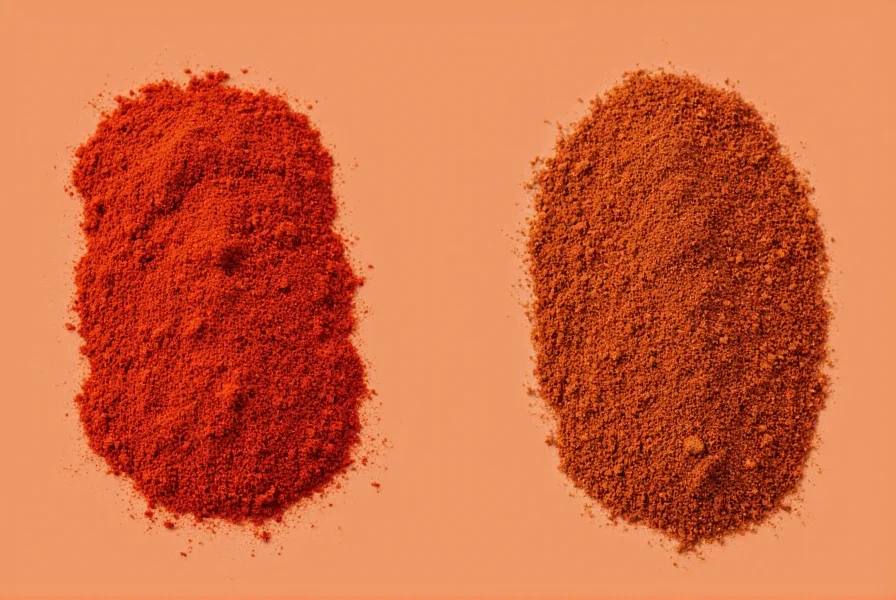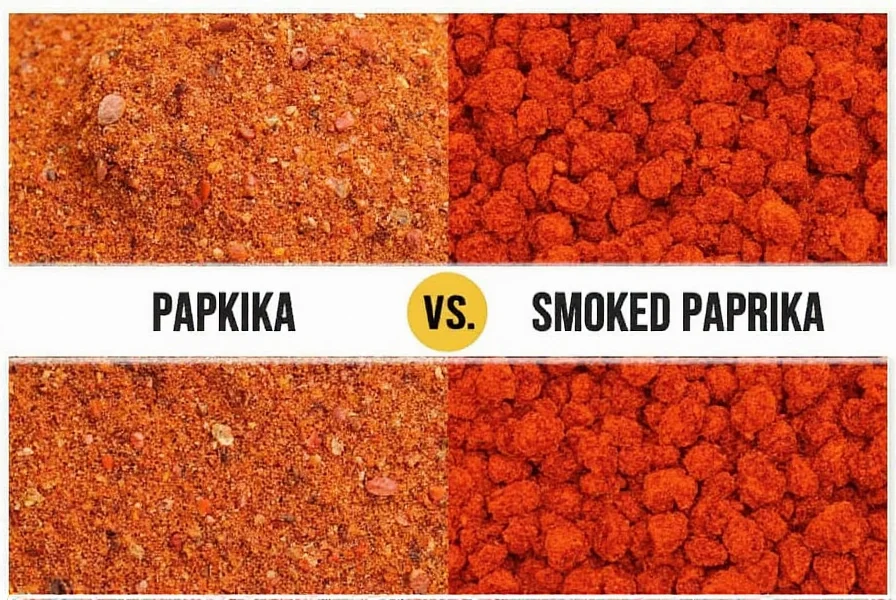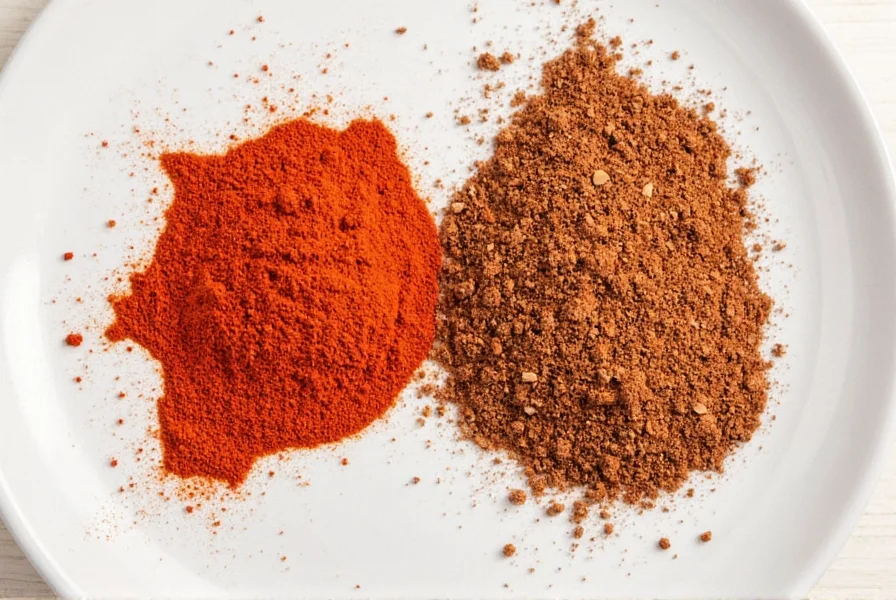Table of Contents
Paprika vs Smoked Paprika: Core Differences
When searching for paprika vs smoked paprika, the fundamental difference lies in their production method and resulting flavor profile. Regular paprika is made from ground dried sweet or hot peppers, while smoked paprika undergoes an additional smoking process where peppers are dried over oak wood fires for up to 15 days, creating a distinct smoky flavor that regular paprika lacks entirely. This single difference dramatically impacts their culinary applications.
Understanding this distinction is crucial for home cooks and professional chefs alike. Using the wrong type can completely alter a dish's intended flavor profile. While both come in sweet, bittersweet, and hot varieties, the smokiness of smoked paprika adds a complex dimension that regular paprika cannot replicate.
| Characteristic | Paprika | Smoked Paprika |
|---|---|---|
| Production Method | Air-dried peppers ground into powder | Peppers smoked over oak fires for 10-15 days before grinding |
| Flavor Profile | Earthy, slightly sweet, bell pepper-like | Deeply smoky with varying heat levels (sweet, medium, hot) |
| Heat Level Range | 0-500 SHU (sweet) to 5,000-10,000 SHU (hot) | 0-500 SHU (sweet smoked) to 8,000-10,000 SHU (hot smoked) |
| Best Cooking Applications | Coloring sauces, rubs for poultry, potato salads, deviled eggs | Barbecue rubs, paella, chorizo, roasted vegetables, braises |
| Substitution Ratio | N/A | Use ¼ tsp liquid smoke + 1 tsp regular paprika per 1 tsp smoked paprika |

Flavor Profiles Compared
Regular paprika offers a clean, sweet pepper flavor with earthy notes ranging from mild to hot depending on variety. Hungarian sweet paprika provides the classic vibrant red color with minimal heat, while Spanish sweet paprika tends to be fruitier. Hot paprika varieties deliver noticeable heat without smokiness.
Smoked paprika's flavor is defined by its smoking process. Authentic Spanish Pimentón de la Vera (with Protected Designation of Origin status) must be smoked for 10-15 days over oak fires, creating complex flavor compounds. Sweet smoked paprika (pimentón dulce) offers mild smoke with zero heat, while hot smoked varieties (pimentón picante) deliver both smoke and heat. The smoke flavor in quality smoked paprika should be clean and woodsy, not acrid or artificial.
Cooking Applications and Substitution Guide
Knowing when to use each variety is essential for authentic flavor development:
- Paprika applications: Add during final cooking stages as heat diminishes its flavor. Ideal for potato salad (1 tsp), deviled eggs (½ tsp), cheese spreads, and coloring tomato sauces without altering flavor profile. In baking, use ¼-½ tsp in savory scones or breads.
- Smoked paprika applications: Can withstand longer cooking times. Use in barbecue rubs (2 tsp per pound of meat), paella (1-2 tsp), roasted vegetables (1 tsp), and bean stews (1-2 tsp). For authentic Spanish chorizo, use 1-2 tbsp per pound of meat.
- Substitution ratios: Replace 1 tsp smoked paprika with 1 tsp regular paprika + ⅛ tsp liquid smoke (use sparingly). Never substitute regular for smoked paprika 1:1 in traditional Spanish recipes as it will lack essential smoky dimension.
- Pro technique: Bloom both varieties in 1 tsp oil over low heat for 30 seconds before adding other ingredients to maximize flavor release. Smoked paprika particularly benefits from this technique.

Buying Guide: Quality Indicators
Selecting high-quality paprika requires attention to specific details:
Authentic Paprika Selection
Look for these markers of quality:
- Hungarian paprika: Should display "Magyar paprika" with region designation (Édesnömegről for sweet, Csípős nömegről for hot)
- Color intensity: Vibrant red color that doesn't appear faded or brownish
- Aroma test: Strong, sweet pepper scent when opened (avoid if scent is musty or weak)
- Ingredient list: Should contain only "paprika" or "ground red peppers"
Authentic Smoked Paprika Selection
Critical indicators for genuine smoked paprika:
- Protected designation: Look for "Pimentón de la Vera" with DOP (Denominación de Origen Protegida) certification
- Smoking method: Authentic versions specify "smoked over oak" (not "artificially smoked" or "with smoke flavor")
- Color variation: Sweet smoked is bright red, bittersweet is darker red, hot smoked is deep burgundy
- Regional authenticity: Spanish smoked paprika typically superior to generic "smoked paprika"
| Brand | Type | Best For | Quality Indicator |
|---|---|---|---|
| La Dalia | Sweet Hungarian | Goulash, potato salad, deviled eggs | "Édesnömegről" designation |
| La Chinata | Sweet Smoked (DOP) | Paella, roasted vegetables, mild sauces | DOP certification seal |
| Hungaricum | Hot Hungarian | Spicy sausages, hearty stews | "Csípős nömegről" label |
| Artajona | Hot Smoked (DOP) | Chorizo, barbecue, bold stews | La Vera region specification |

Storage Best Practices
Proper storage maintains potency and prevents flavor degradation:
- Air exposure: Store in airtight containers immediately after opening (glass jars with tight lids preferred)
- Light sensitivity: Keep in dark cabinet away from sunlight (clear containers lose potency 50% faster)
- Temperature: Store below 70°F (21°C) - refrigeration extends shelf life but may cause clumping
- Shelf life: Regular paprika: 2-3 years; Smoked paprika: 3-4 years due to smoke's preservative qualities
- Freshness test: Rub ¼ tsp between fingers - fresh paprika leaves vibrant red stain and strong aroma
Frequently Asked Questions
What's the fundamental production difference between paprika and smoked paprika?
The core difference is in the drying process. Regular paprika uses air-drying methods, while authentic smoked paprika undergoes a traditional smoking process where peppers dry slowly over oak wood fires for 10-15 days. This smoking process creates complex flavor compounds (guaiacol and syringol) that give smoked paprika its distinctive taste. Regular paprika contains none of these smoke-derived compounds, resulting in a clean pepper flavor without smokiness.
Can I accurately substitute regular paprika for smoked paprika in recipes?
Not perfectly, but you can approximate the flavor. For each teaspoon of smoked paprika required, use 1 teaspoon regular paprika plus ⅛ teaspoon liquid smoke. However, this substitution lacks the nuanced complexity of authentic smoked paprika. Never substitute 1:1 as the flavor profiles are fundamentally different - regular paprika provides color and mild pepper flavor while smoked delivers essential smokiness. In traditional Spanish recipes like paella, substitution significantly alters authenticity.
How can I verify if my smoked paprika is authentically smoked versus artificially flavored?
Examine the ingredient list: authentic smoked paprika lists only "smoked peppers" or "pimentón" while artificially flavored versions include "smoke flavor" or "liquid smoke." Authentic Spanish Pimentón de la Vera carries a DOP (Denominación de Origen Protegida) certification seal. Additionally, authentic smoked paprika has a complex aroma with woodsy notes rather than a单一 acrid smoke smell. When dissolved in warm oil, authentic versions release subtle floral notes alongside the smoke, while artificially smoked versions deliver one-dimensional smoke flavor.
Why does smoked paprika cost significantly more than regular paprika?
Smoked paprika costs more due to its labor-intensive production. The traditional smoking process takes 10-15 days of constant monitoring over oak fires, compared to regular paprika's simple air-drying. Authentic Spanish Pimentón de la Vera requires specific pepper varieties grown in designated regions and follows strict production protocols. The slow smoking process yields less final product (peppers lose 80% of weight during smoking), and quality control standards are significantly higher. Protected designation status also limits production volume, contributing to higher prices.
When should I add each type during cooking for optimal flavor?
Add regular paprika late in cooking (last 5-10 minutes) as its flavor compounds degrade with prolonged heat exposure. Smoked paprika's flavor compounds are more heat-stable, so it can be added earlier - at the beginning of braising or during the initial oil-blooming stage. For maximum flavor from either variety, bloom in 1 teaspoon of oil over medium-low heat for 30 seconds before adding other ingredients. Never add either directly to high heat as this creates bitterness. In baking applications, mix paprika with dry ingredients to prevent clumping.
Conclusion
Understanding the precise differences between paprika and smoked paprika transforms your cooking accuracy. Regular paprika delivers pure pepper flavor and vibrant color, while smoked paprika provides an irreplaceable smoky dimension essential for authentic Spanish and Hungarian dishes. The production method difference - air-drying versus traditional oak-smoking - creates fundamentally distinct flavor profiles that cannot be perfectly substituted.
For optimal results, select region-specific varieties with proper designations (DOP for Spanish smoked paprika, Édesnömegről for Hungarian sweet), store properly in airtight containers away from light, and add at the correct cooking stage. While both spices enhance dishes, recognizing when each is appropriate ensures authentic flavor development. The next time you reach for paprika, consider whether your dish requires the clean pepper notes of regular paprika or the complex smokiness that only genuine smoked paprika can provide.










 浙公网安备
33010002000092号
浙公网安备
33010002000092号 浙B2-20120091-4
浙B2-20120091-4